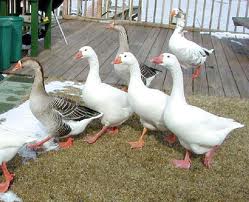{[[' ']]}
']]}
The domestic goose, as history would note, is one the earliest domesticated animals in the world, with evidence of their domestication dating back to the glory days of ancient Egypt some 4000 years in the past.
Typically kept for the same reasons why chickens are kept – for their food commodity value – they are also kept as alternatives to guard dogs, given their overly territorial inclinations on the presence of intruders and strangers, though this reason for their keeping isn’t as popular as their “function” in grand dinner celebrations.
The 1995 released Babe, which centered around a pig as its main protagonist, featured an interesting domestic goose character, one who was inclined to “offer” an extra service to avoid becoming the dinner table’s main feature: to double as the farm’s rooster, crowing early in the morning.
Though crowing early in the morning is not something all domestic geese are liable to do, domestic geese can be quite loud, and with their long necks and beaks, they can actually attack people, individually or in a group.
Apart from their value as food commodities, domestic geese are also kept for their feathers and for their eggs, with their feathers used and valued as fiber fillings or fillers. The eggs of geese, as the classic “golden goose” myth would tell, are also considered to be economically valuable, though the myth of the “golden goose” is one that tells of the dangers of greed and laziness.
As mainstay farm animals, the domestic goose stands to be one the most commonly encountered, bunched together with pigs, cows, chickens and farm dogs. Though they don’t always bear particular operational roles in the farm, they are often valued for their poultry-food-commodity aspects, as well as for their extended guarding instincts.
Domestic Goose Video














Post a Comment